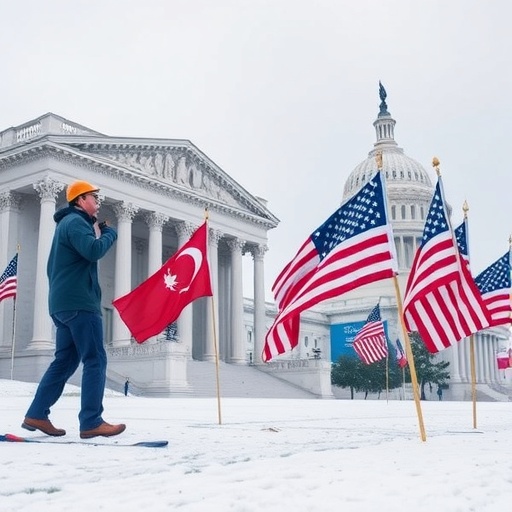US Economic Growth Stalls as Government Shutdown and Trade Uncertainty Bite Hard
In a stark warning for the world’s largest economy, the latest GDP figures reveal that U.S. Economic Growth slowed to a mere 1.4% annualized rate in the fourth quarter of 2018, down from 3.4% in the previous period. Economists attribute this deceleration directly to the protracted government shutdown, now in its 25th day, and escalating trade uncertainty with China and other trading partners. As federal workers go unpaid and global supply chains falter, the ripple effects are threatening to push the U.S. toward recession territory, with consumer confidence plummeting and business investments frozen.
- Shutdown Paralyzes Key Sectors, Draining Billions from the Economy
- Trade Tensions Escalate, Hammering Manufacturing and Exports
- Air Traffic Nightmares Threaten Holiday Travel and Commerce
- Military Paychecks Bounce, Straining National Security and Families
- Economists Sound Alarm: Recession Risks Mount Without Swift Resolution
Shutdown Paralyzes Key Sectors, Draining Billions from the Economy
The government shutdown, triggered by a partisan standoff over border wall funding, has furloughed over 800,000 federal employees and halted operations at dozens of agencies. This isn’t just a Washington D.C. headache; it’s a nationwide economic drag. According to the Congressional Budget Office (CBO), the shutdown is costing the U.S. economy approximately $1.5 billion per week in lost productivity and services. Federal contractors, numbering in the hundreds of thousands, are also feeling the squeeze, with companies like Boeing and Lockheed Martin reporting delays in government-funded projects.
Take the National Park Service, for instance. Iconic sites like Yosemite and the Grand Canyon have been operating on skeleton crews, leading to trash buildup and safety hazards that deterred an estimated 3 million visitors during the holiday season. This alone translates to a $200 million hit in tourism revenue, per a report from the U.S. Travel Association. “The shutdown is like a slow-motion train wreck for the economy,” said Mark Zandi, chief economist at Moody’s Analytics. “We’re seeing immediate pain in consumer spending, and it’s compounding the trade uncertainty that’s already weighing on exports.”
Beyond parks, the shutdown’s impact on food safety inspections is alarming. The Food and Drug Administration (FDA) has paused routine checks on imported seafood and produce, raising fears of contaminated goods slipping through. In December alone, over 1,000 inspections were canceled, potentially exposing consumers to health risks and inflating import costs as businesses scramble for alternatives.
Trade Tensions Escalate, Hammering Manufacturing and Exports
Compounding the domestic chaos of the government shutdown is the brewing storm of trade uncertainty. President Trump’s tariff escalations on Chinese goods, now covering $200 billion in imports at 25% rates, have disrupted global supply chains and eroded business confidence. The U.S. Census Bureau reported a 4.9% drop in exports for November 2018, the steepest decline in nearly a decade, with soybeans and aircraft leading the losses. American farmers, hit hardest by retaliatory tariffs from Beijing, have seen soybean exports to China plummet by 75% year-over-year, forcing the government to dole out $12 billion in emergency aid.
Manufacturing, a bellwether for Economic Growth, is reeling. The Institute for Supply Management’s manufacturing index dipped to 54.1 in December, signaling contraction in key areas like new orders and production. Companies like General Motors and Ford have announced plant idlings and layoffs, citing tariff-induced cost hikes. “Trade uncertainty is the invisible tax on every American business,” remarked U.S. Chamber of Commerce President Thomas Donohue in a recent op-ed. “It’s not just about steel and aluminum; it’s about the unpredictability that’s scaring off investments.”
Globally, the IMF has slashed its 2019 U.S. growth forecast to 2.5% from 3%, warning that prolonged trade uncertainty could shave off another 0.5 percentage points. In the tech sector, giants like Apple are bracing for impacts, with CEO Tim Cook noting in a letter to investors that escalating tariffs could add $6 billion to production costs for iPhones assembled in China.
Air Traffic Nightmares Threaten Holiday Travel and Commerce
As the government shutdown drags on, aviation safety hangs in the balance. The Federal Aviation Administration (FAA), operating with reduced staff, is facing a shortage of 10,000 air traffic controllers—a deficit exacerbated by mandatory furloughs. Delays have already surged 20% at major hubs like Atlanta and Chicago, according to FlightAware data, stranding thousands of passengers and costing airlines millions in reimbursements.
Experts warn of worse to come. “Without full staffing, we’re one storm away from a major meltdown,” said Paul Rinaldi, president of the National Air Traffic Controllers Association. The union has highlighted fatigue among remaining workers, who are pulling overtime shifts without hazard pay. This comes at a peak travel time; the Air Transport Association projects 3.4 million passengers daily through January, a 4% increase from last year. Any widespread disruptions could amplify the economic growth slowdown, as e-commerce giants like Amazon rely on air freight for timely deliveries.
The ripple effects extend to cargo. With FAA inspectors sidelined, aircraft maintenance certifications are delayed, potentially grounding freighters and bottlenecking the $1.5 trillion logistics industry. A study by the Airlines for America estimates that a prolonged shutdown could cost the aviation sector $1 billion monthly, further eroding consumer spending power amid rising ticket prices.
Military Paychecks Bounce, Straining National Security and Families
Perhaps the most poignant fallout from the government shutdown is the unpaid wages for 380,000 active-duty service members. For the first time in history, U.S. troops are missing paychecks during a shutdown, a situation that Defense Secretary James Mattis called “unacceptable.” Military families, many living paycheck to paycheck near bases in states like Virginia and California, are turning to food banks and credit cards to make ends meet.
The Pentagon has promised back pay once resolved, but the damage is immediate. Food insecurity has spiked, with the Army Emergency Relief fund reporting a 300% increase in assistance requests. “Our soldiers are focused on defending the nation, not worrying about bills,” said Sen. Jack Reed, ranking member of the Armed Services Committee, in a floor speech. This uncertainty is not only demoralizing but also poses risks to readiness; recruitment has already dipped 25% in affected areas, per Pentagon stats.
Trade uncertainty adds another layer, as defense contractors face delays in funding for programs like the F-35 fighter jet. Lockheed Martin, the prime contractor, warned of potential furloughs for 14,000 workers if the impasse continues. Economically, this sector supports 2.5 million jobs nationwide, and any slowdown could drag down economic growth in Rust Belt states already battered by trade wars.
In communities like San Diego, home to Naval Base Coronado, local businesses are suffering. Restaurants and retailers report a 15-20% drop in sales from military patrons, echoing broader consumer retrenchment. A survey by the National Foundation for Credit Counseling found that 40% of federal workers are dipping into savings, accelerating household debt to $9.1 trillion—the highest on record.
Economists Sound Alarm: Recession Risks Mount Without Swift Resolution
Looking ahead, the convergence of government shutdown woes and trade uncertainty is painting a grim picture for 2019 economic growth. The Federal Reserve, in its latest beige book, noted “widespread concerns” about policy volatility, with businesses postponing expansions and hiring. Unemployment claims, while still low at 216,000 weekly, are trending upward, and retail sales growth slowed to 2.2% in December, per Commerce Department figures.
Wall Street echoes these fears. The S&P 500 has shed 5% since the shutdown began, with yield curve inversions signaling potential recession within 12 months. Goldman Sachs economists now peg the odds at 35%, up from 20% pre-shutdown. “If this drags into February, we could see GDP growth dip below 1%,” forecasted Ellen Zentner, Morgan Stanley’s chief U.S. economist. Mitigation efforts, like the Fed’s pause on rate hikes, offer some relief, but experts urge bipartisan action.
Politically, House Speaker Nancy Pelosi has vowed to end the shutdown by January 3, tying it to reopening government without wall funding. Meanwhile, trade talks with China resume in Washington next week, but optimism is tempered by demands for structural reforms. For everyday Americans, the stakes are high: rising inflation from tariffs, coupled with shutdown-induced austerity, could squeeze middle-class budgets. As one furloughed IRS employee told CNN, “We’re the backbone of this economy, and right now, we’re broken.”
The path forward hinges on compromise. If resolved swiftly, analysts predict a rebound in Q1 growth to 2.2%. But prolonged gridlock risks a self-inflicted downturn, underscoring the fragility of the U.S. economic engine in an era of political brinkmanship and global rivalries.








